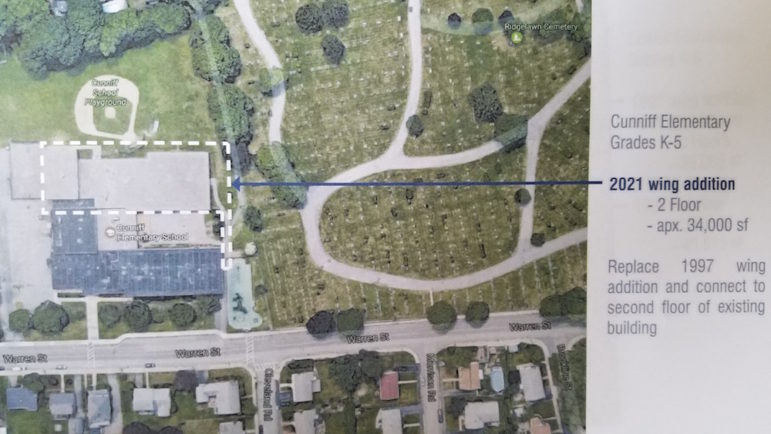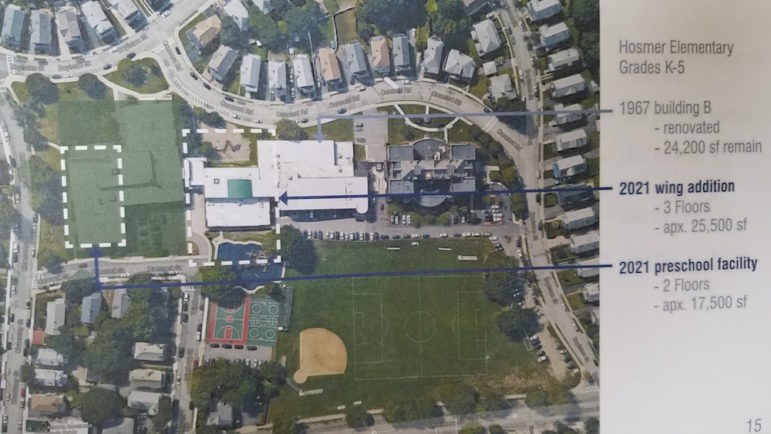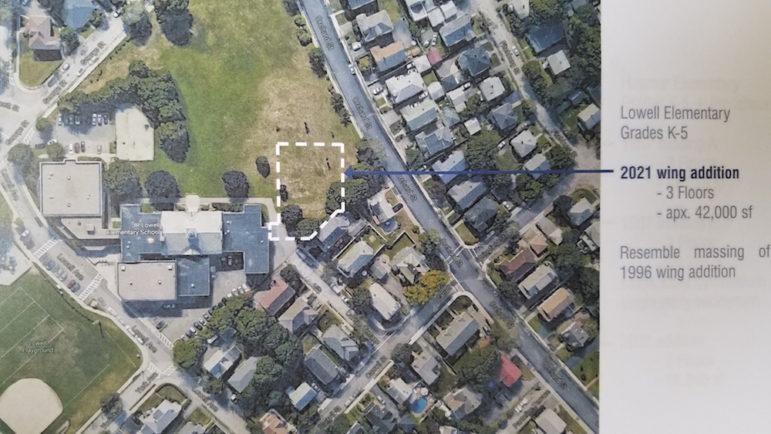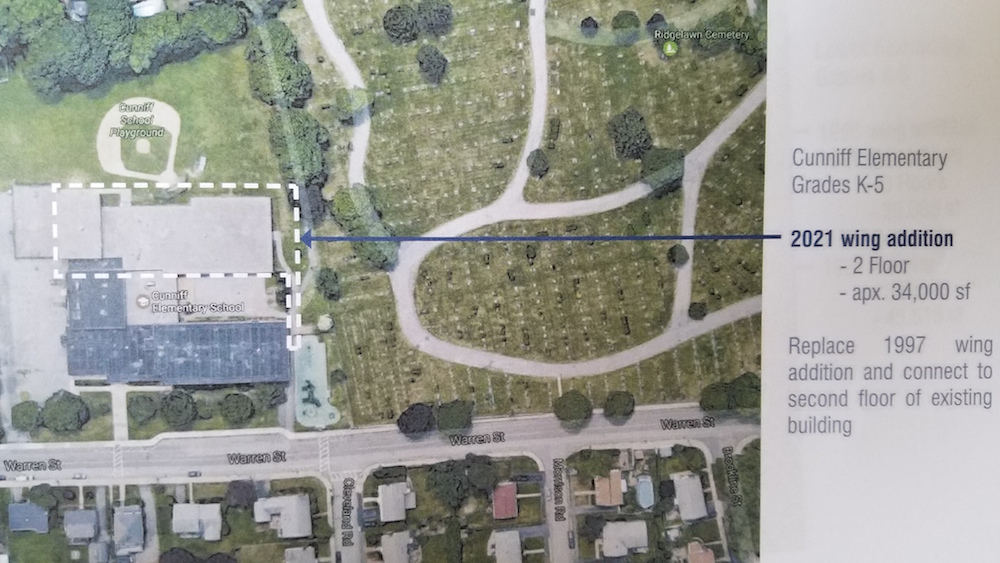
Ai3
A proposal to renovate Cunniff Elementary School includes replacing the one-story wing with a new two-story wing.
An architecture firm hired by the Watertown Public Schools laid out a vision for how all five of the town’s schools could be renovated so they can provide a 21st century education, and recommended doing all three elementary schools at once followed by the high school and finally the middle school.
Thursday night, Ai3 Principal Scott Dunlap presented a plan for upgrading Watertown’s five public schools over the next several years to a meeting held by both the School Committee and Town Council.
Timeline
The timeline laid out by Ai3 – a firm that works solely on school projects – would start planning for the three elementary schools immediately with the goal of starting construction in late 2019 and completing the work by early 2021, Dunlap said. Meanwhile, the district would be working with the Massachusetts School Building Authority (MSBA) to get funding for and renovate Watertown High School. Construction would begin at the high school in early 2021. The timeline does not have an end date for work at WHS.
Being accepted into the MSBA program can be tough, with only about 30 schools out of 150 applicants chosen each year, Dunlap said. This is the fourth year that Watertown has applied to be part of the MSBA program, but Dunlap is confident the school will be accepted this year.
“The high school has the needs to get into the School Building Program,” Dunlap said. “The School Committee reworked the application and now it is in good position to move forward and be awarded a grant.”
Watertown Middle School was also examined, and Dunlap suggested renovating the school through the MSBA program, which would provide up to half the cost of the construction. However, the district can only have one school in the state program at once, so the middle school would have to wait until after work at the high school is done.
Dunlap recommended that the elementary schools not be done through the state’s program in part because only one school can be worked on at once, plus it would not be as cost effective because the state will not pay for work on auditoriums and gyms at elementary schools.
Ai3 was hired to review school facilities studies and come up with a game plan and schedule for renovating the schools. The firm also designs schools, but School officials have not yet chosen an architectural firm to design the schools.
Elementary Schools
Dunlap recommended working on all three elementary schools at once, rather than one at a time. He said that would allow the district to hire one contractor, save money by avoiding rising construction costs and it would likely be more popular with parents.
“We found if you split them up and do not do all the projects at the same time there is a lack of confidence (from parents of schools later in the schedule) that the construction will eventually get to their school,” Dunlap said.
One question School officials have had is whether the elementary schools could be renovated while keeping the existing schools open, or whether “swing space” would be needed off site to move some students during construction. Dunlap said he believes the students could remain at their schools while the work is done.
Some worried about noise and other factors, such as air quality, for students and staff when schools are in session during the construction period. Dunlap said classrooms would not be immediately adjacent to construction zones. Safety would also be addressed.
“There are a lot of stringent requirements to ensure there is good air quality,” Dunlap said. “A licensed site professional, overseeing the environment in the building, works on any project we do and we would suggest you do so. They are on site daily monitoring those types of things.”
School officials should have the architect design options for renovation and for full reconstruction for each school so they weigh the options, Dunlap said. He added, however, that renovation will be less costly.
The renovations of the schools would provide spaces designed for 21st century education, which includes spaces for group and collaborative learning, hands-on lessons, and places for teachers to meet and plan. Also, the schools would be fully air conditioned.
“We haven’t designed a school that wasn’t fully climate controlled since 2002,” Dunlap said. “Every school we design is fully air conditioned and fully climate controlled because they are used year-round and has community use.”
Cunniff Elementary School
Cunniff has had the most pressing space needs of all the Watertown Schools. Dunlap said the school could be expanded by building a two-story wing on the spot of the current one-story classroom wing (see photo at top). He does not believe the existing building would be able to support a second story, so a new wing would need to be constructed.
The school also could be a candidate for a brand new school, which could be done by tearing doing the one-story wing, and build a new school on that spot and extending into part of the playing fields behind the school. The old school would then be torn down to provide more field and playground space.
There are six classrooms in the one-story wing, which would need to be replaced during construction by modular classrooms. Dunlap said modern modulars are very popular with teachers, and have air conditioning and good acoustics.
Hosmer Elementary School

Ai3
At Hosmer, a likely plan would be to knock down the center connector with a new classroom building, renovate the auditorium and gym and replace the old classroom wing with a new preschool.
Hosmer School is a mishmash of buildings, with a classroom building and an auditorium and gym built in 1967, and a connector built in 2002. Parts of the old classroom building cannot be brought up to modern standards, Dunlap said, and the connector is not used well. Parts of the Homer building get very cold in the winter and sweltering in hot weather.
One of the more likely scenarios at Hosmer would be to tear down the 2002 addition and replace it with a new classroom building. The auditorium and gym would be kept and renovated and part of the existing classroom wing would be renovated. The other part of the old wing would be knocked down at the end of the project and a new preschool building would be built in its place. Most students would be able to stay in the school during construction, Dunlap said, but the preschool (located in the 2002 addition) would be moved into modular classrooms during construction.
Lowell Elementary School

Ai3
The most likely scenario for renovation of Lowell School would be adding a new classroom wing on the west side of the school.
The layout of the rooms at Lowell Elementary School, including some larger classrooms, makes it flexible enough to provide 21st-century teaching, Dunlap said.
A likely plan for Lowell Elementary School would be to add a three-story classroom wing on the west side of the building, mirroring the 1996 addition on the east side, Dunlap said. Students could remain in the school during construction with no need for modular classrooms, he said.
Watertown High School
The focus of the meeting was on the three elementary schools, but Dunlap said that the most likely scenario for the high school would be to renovate the current building. Part of the focus would be to use the space in the 1970s addition (closest to the cemetery) and use it more effectively.
Some suggested looking for a spot to build a new high school. Councilor Aaron Duskhu said he believes there could be a similar sized lot if the land where the Lowell School is located is combined with the property that includes the school’s upper playground and playing field. Dunlap said he had not looked at that scenario, but ruled out using the space in front of the school because of the significant elevation change on that hill.
Recreation Director and Watertown Parent Peter Centola said he likes the idea of building a high school at the Lowell site. Parent Kate Coyne said she believes the Lowell School sitting on top of the hill is one of the town’s gems and she would not want to see it knocked down.
One major hurdle for tearing down the Lowell, as well as parts of the high school and middle school, is the historic status of the buildings, Dunlap said. The schools have historic status under the state’s rules, and the Massachusetts Historical Commission would need to approve the demolition of the historic portions. He noted that there are different and more strict rules for demolishing public buildings compared to private homes.
Watertown Middle School
Renovation of Watertown Middle School would be many years down the road. Dunlap said the school has been able to work with the current configuration.
“The school is usable and the staff is not letting the floor plans prevent them from creating innovative, project-based programs,” Dunlap said.
The middle school does have needs, Dunlap said, and he believes it would also qualify for MSBA funding, but that will have to wait until the high school project finishes.
Planning and Paying for the Projects
To get the project rolling to meet the timeline laid out by Ai3, the School Committee and Town Council will soon have to approve funding for a firm to do schematic designs and to hire an owner’s project manager (OPM) to oversee the work on the three elementary schools. He estimated it both of those would cost a total of $1.5 million to $1.6 million for the three elementary schools. According to the timeline the Town would need to approve the funds by mid-September, and an architectural firm and OPM would need to be hired by the end of October.
Completing schematic designs would take about a year, at the end of which school officials would know what the schools would look like, have detailed floor plans, plans for internal systems and have a firm construction cost estimate.
With those items in hand, School and Town officials could go to the voters for approval of funds to pay for the project. That would happen in November 2018 under Ai3’s timeline. Some districts pay for the entire project with bonds approved in a debt exclusion, Dunlap said, while others use a combination of a debt exclusion and use some money saved by the town.
The high school would follow a similar route, but before they can get to the point where officials can hire a firm to do schematic designs they must first go through the MSBA process, Dunlap said. First, the high school would need to be invited to be part of the state’s program, then the district must pull together documents to submit to the state (including an education profile, enrollment projections and maintenance documents). Finally, funding for schematic designs must be approved. Dunlap said the cost of schematic design and hiring an OPM for the high school would be about the same as the elementary schools – around $1.5 million.
The schematic design for WHS would occur during 2019, and then the town could seek another debt exclusion in early 2020 to pay for the renovation or construction, Dunlap said.
School Committee Chairman John Portz said the discussion of approval of schematic design funds would begin at the Aug. 14 School Committee meeting. Dunlap will be at that meeting, too, he said. The funds to hire an architectural firm and an OPM must be approved by the Town Council, Portz said.
Portz added that a building committee would need to be appointed to oversee the project, and that committee is appointed by the Council.
Thursday’s meeting was the first official meeting for new Superintendent Dede Galdston. She said she and her staff are “poised and ready to get us to the point where we are ready to construct these buildings.”
Galdton has experience with the MSBA, having helped build a new high school in her former position as assistant superintendent in Billerica. Also, Watertown’s Assistant Superintendent of Finance and Operations Mary DeLai helped build schools when she was superintendent in Wilmington.
Galdston said that while buildings do not teach students, the current Watertown schools have their limitations.
“When we think about preparing students for the future, we think about what industry wants – creative thinking, problem solving, innovation,” Galdston said. “We have come to the point where we can’t do that anymore.”
She added that the name of program to renovate Watertown’s schools – Building for the Future – works on two levels.
“That is what we are doing, not just building buildings, we are also preparing students for their future,” Galdston said.

The Hosmer School plan calls for a building where both playgrounds currently are. So where are they going to be moved to?
That’s a good question. They did not go into that, but I am sure that will be covered during schematic design. These are VERY preliminary plans.
Wow, when will this Town ever figure it out??????? For the past forty years , or so, we have added one addition after another to old school buildings, and spent millions on renovations, only to hear later that they are insufficient; too small, too poorly designed and/or not up to today’s standards.
In the 1980’s the Town even sold the Parker School to pay for the new windows for Watertown High. Said Windows which failed so miserably that the company that manufactured them went bankrupt, meaning parts could not be purchased to fix them within ten years. Another disastrous decision in hind sight!
The fact is that Watertown High School is amongst the oldest, most delapidated school building in our Town, if not Eastern Massachusetts.
In my opinion, we can’t continue to pretend that we care about education and keep putting band-aids on old buildings. Investing in education should mean more than just talking about it. There’s a reason why more than half the communities in the Middlesex League have built new high schools and are generally ranked as better schools systems compared to our town.
So, let’s put this into perspective. My mother is 99 years old and she attended the same Watertown High School which I did in 1975 ……on Columbia Ave. Then in the 1980’s we built the major gym addition, arts and music rooms that are now too small and did little for classroom space. I assume that’s why the present contractor states, “the space could be used better!”
There’s a reason why families, particularly with high school aged children, continue to look at Watertown as a sub par residential choice compared to our neighboring towns. Heck, Newton North has been completely demolished and rebuilt twice in the last 50 years. I believe they also rebuilt Newton South during that time plus numerous elementary schools.
Ok, some will say that Newton is a much bigger and more affluent city as compared to Watertown. To that I say Melrose, Woburn, Burlington and Reading (just to name a few) have all built new state of the art high schools in recent years. Belmont was rebuilt in the 1970’s and they’re talking about building a new high school, too.
I believe it’s the complete refusal of our Town to invest in and build new schools that strongly contributes to the poor rankings for Watertown Public Schools. For the record, I’m completely satisfied that our teaching staff is as good as any of the schools in the much higher regarded Brookline, Newton, Lexington and Belmont school systems.
I ask my fellow Watertown residents to call on all our public elected officials, including but not limited to, our School Committee Members and Town Counselors to stop just “kicking the can down the road with this decades-long renovation agenda.” We have successfully built a new state of the art Main Fire Station, Police Station and a DPW Department in recent years.
Isn’t it about time to INVEST IN WATERTOWN AND BUILD NEW SCHOOLS?
Len Holt
Grenville Road
While there are some good points in your message, the number one problem with Watertown schools is funding by the residents. The reason that our neighbors (except Waltham) have much better schools is that the residents of those towns pay MUCH higher taxes to fund their schools. Average tax bill in Watertown is about $5k/yr. The average tax bill in Belmont, Lexington and Newton (as examples) is $10-11K/yr.
Schools are an investment that Watertown residents as a whole have chosen not to make. If you want to change the “character” of Watertown from a “lower cost commuter town” to a “high cost town with great schools”, it is going to require big changes in how the town is run and funded. This kind of change is possible, and perhaps desirable for some residents, but don’t expect all (or likely even a majority) of the residents to support drastically changing their costs and reasons for living here.
Sadly, there is truth in both comments here. I’ve been reflecting on how disappointed I am that decisions made 5, 10, 15 …. even 40 years ago have negative impacts made on students today. This is a legacy of giving very low priority to education. These are not exciting topics but places with great schools think more about how elected and appointed town officials support the education system, the qualifications needed in school committee members, and how to effectively ensure that the central administration is accountable for the quality of education. People haven’t pushed for better. We haven’t fought enough for better (present company included). So what do we have now? A mediocre district (on the rise) but 5-10 years behind others. And we have dirty old buildings that are holding us back. As the Ai3 architect said in the public meeting, past renovations to WMS were done in the cheapest way possible with low quality materials. This is everyone’s fault because we didn’t pay attention.
What I’ve seen is a pattern such that families and *kids* that care deeply about education quality, ultimately send their children to private schools, move to other districts, or cross their fingers and say a lot of prayers. On average, the rest of us pay little attention until major issues happen (teachers work to rule, we run out of paper, a logo is changed, the Cunniff is over-crowded, a superintendent threatens to move kindergarten classes etc). These events outrage people and we pay attention. The issue is resolved and then schools are off the radar and we don’t think about the fact that we’ve slipped so far behind other districts with regards to quality and the ability of the schools to meet the needs of all of our students. We also have a culture that is often antagonistic to academic excellence. Students, parents, and even teachers in some cases promulgate this culture of mediocrity. This is why 13-14%+ of WMS students are choosing to leave our schools system and go private this year, rather than to WHS. From lots of discussions, I heard over and over again, the kids pushed their parents to send them outside of WHS. My daughter came home from the tour and said “Mom, I cannot go there. Please, do not make me go there. I care about my future” The building plays a role. The culture plays a role.
If Watertown wants to be a great district, people are going to have to work to get there. QUIT electing the same people that got us into this mess. Ask those who have held us back to resign. Now. Pay attention to what your officials are doing during meetings. Ask them how they prepare for meetings. Ask them how they know whether our academic offerings and student achievement is where it should be. For example, ask for evidence to show that say early grade reading is (hint: we are NOT where we should be.) Push back on anyone who defends our scores, rather than saying, “Yes, I know this is a huge problem and here’s how we’ll fix it…” Actually sit down and look at this year’s budget presentation. One thing you will see is a carefully laid out story of how our past superintendent went on a hiring frenzy which yielded no improvements in student achievement to show for it. Who was paying attention as this happened? Who stood up for the kids that weren’t doing much better despite this? Not many of us (and I certainly didn’t do it enough.)
Please, please, please Watertown, pay attention. Stop accepting mediocrity. Invest your time, ideas, and money into public education. Kids deserve better.
The presentation last week by Ai3 was an early step in a long, but very important and exciting path for WPS. As many people have commented, our five schools date back many years (several to the 1920s). There have been additions and improvements along the way, but we need much more. We need new learning spaces that can support today’s teaching styles and today’s students. The purpose of the next phase – schematic design – is to provide more detail on what those spaces can look like at the three elementary schools. The proposals to come from this – whether in new building spaces or renovation of current space – will provide a redesign of the entire building, not a band-aid on part of the building. Designing these spaces will draw upon the creativity of teachers in those buildings as well as parents and the community. I know the educators throughout the district are excited about shaping this future.
Buildings are a critical piece, but it’s most important what happens inside each school building. There are outstanding teachers and learning experiences happening throughout the district. Can we get better? Absolutely. We need to make sure every classroom provides an excellent learning experience. Every organization should strive to improve. From teachers and aides in the classroom to our new superintendent and central office as well as the school committee, there is a strong commitment to provide the best education possible for Watertown’s students. And, contrary to an earlier post, the town has shown commitment as well with strong financial support for the schools. However, where we fall short, we need to work harder to get back on track. That takes time and perseverance now and into the future. I look forward to working with others who share those goals.